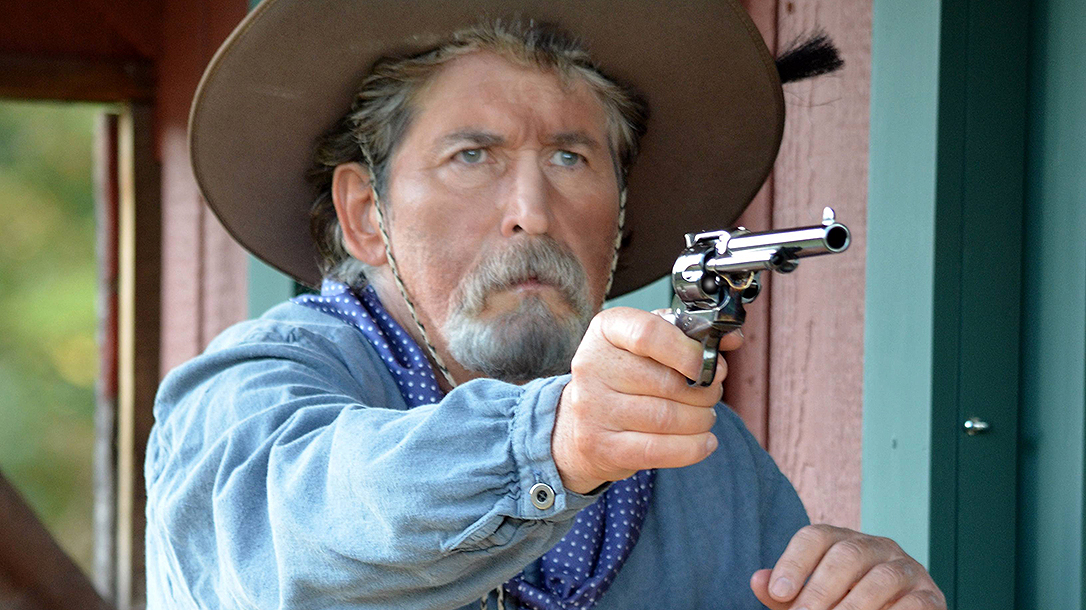Over the past 15 years, Guns of the Old West has featured a variety of handcrafted revolvers and holsters duplicating famous guns and gun leather from historic figures of the American West and, occasionally, equally famous fictional characters. Among those are perhaps two of the most celebrated figures of the 19th century, Buffalo Bill Cody and Geronimo.
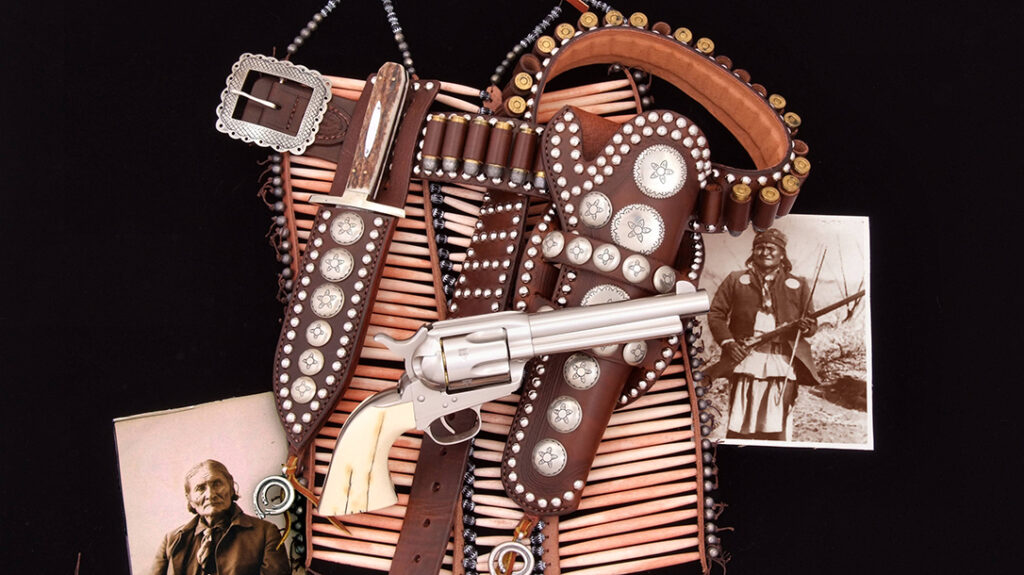
Great Old West Guns
For Guns of the Old West, a duplicate of Geronimo’s nickel-plated Colt Single Action Army with 5-1/2 inch barrel and ivory grips was created by John J. Adams, Sr., while Alan and Donna Soellner of Chisholm’s Trail Leather researched and constructed a prefect duplicate of the famous Chiricahua Apache’s Mexican double drop loop holster and scabbard, (both covered in handmade silver conchos and silver studs), and George Wostenholm spear point Bowie knife. The Soellners traveled to the Ft. Sill National Historic Landmark where the original Geronimo holster, knife and gun have been carefully preserved in a special exhibit. They were allowed to photograph, measure, and examine each piece of the collection in order to create the duplicate for Guns of the Old West.
Advertisement — Continue Reading Below
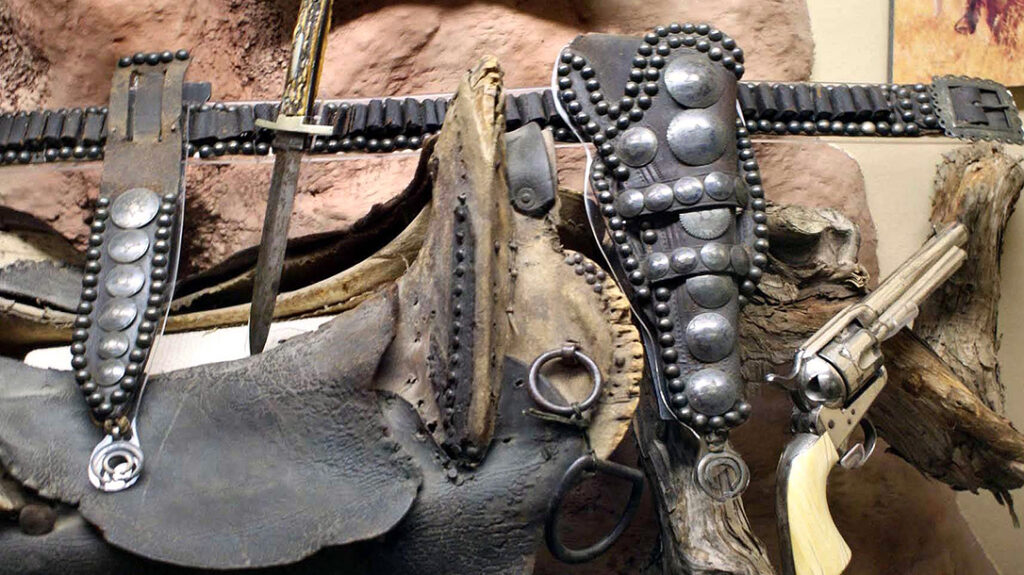
Behind the Gun
In May 1885, after being pursued by the U.S. Army under General George Crook, Geronimo and his warriors finally surrendered, but then escaped from the San Carlos reservation and fled back into Mexico. After crossing back into the United States Geronimo surrendered for the last time to General Nelson Miles in September 1886, realizing that to do otherwise would mean their extinction. They were eventually relocated to Fort Sill, Oklahoma.
When Geronimo surrendered for the last time on September 4, 1886, he was wearing the originals of this rig and Colt SAA. The guns carried by Geronimo at the time of his surrender are well documented. His Winchester Model 1866 lever-action rifle (serial number 109450), which had a silver washed receiver and barrel, uncharacteristic but not unprecedented for the brass-framed Model 1866, is on display at the West Point museum, and his nickel-plated Colt Single Action Army revolver (serial number 89524) is in the special display at Fort Sill along with his elaborately decorated holster.
Advertisement — Continue Reading Below
According to Colt’s factory records, the gun carried by Geronimo was delivered to Hartley & Graham in New York City on May 15, 1883. The Colt Peacemaker was originally nickel-plated and fitted with a 5-1/2 inch barrel. The factory records make no mention of the grips, but it was not uncommon for Harley & Graham to fit their top-of-the-line guns with ivory stocks. How the gun got from New York City in 1883 and into Geronimo’s holster by 1886 is anyone’s guess, but suffice it to say Geronimo was not the original purchaser.
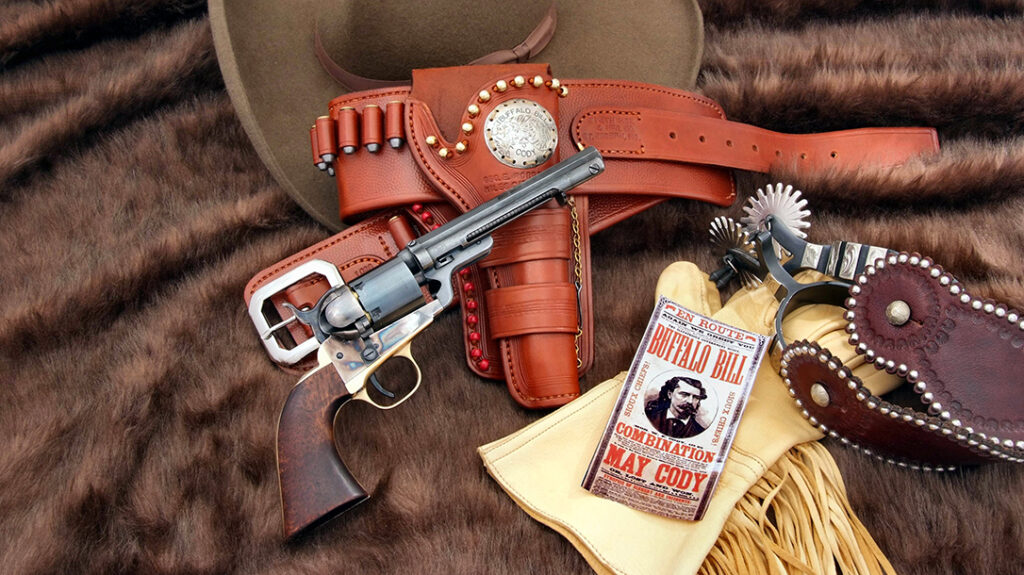
Buffalo Bill
Despite William Frederick Cody’s real-life contributions to American frontier history, he gained his greatest fame in show arenas around the world with an outdoor extravaganza staged on a scale more colossal than anything that had gone before it. Beginning in 1883, “Buffalo Bill’s Wild West” represented the birth of the Western as an entertainment phenomenon, using a cast of hundreds, as well as live buffalo, elk, cattle, and other animals. For an amazing three decades, he delighted spectators with performances by the original “King of the Cowboys” Buck Taylor, legendary sharpshooters Johnny Baker (“The Cowboy Kid”), Annie Oakley and her husband Frank Butler, Lillian Smith, Doc Carver, and Dr. Frank “White Beaver” Powell, among others.
Advertisement — Continue Reading Below
The Wild West Show
Cody’s Wild West played at venues from San Francisco to Madison Square Garden, to command performances in Great Britain, France, Spain, Italy, Belgium, the Netherlands, Germany and even the Vatican. Millions of people the world over learned of the American West through Cody’s shows, and perhaps through Cody’s eyes. It was the theatrical version of history, always a bit more entertaining and harrowing than real life. There were cattle rustlers, ropers and trick riders; stagecoach chases, a buffalo hunt, and even Sitting Bull played himself in Cody’s Wild West for one season, in 1885.
Over the decades the show changed but Cody was there until the end, until all he could do was ride into the show arena and doff his hat to the crowds. In 1915 Cody, who was in his late sixties, appeared in 366 performances over a 183-day period. When Buffalo Bill died in Denver, Colorado, at age 70, Johnny Baker (Cody’s foster son, who had been with the show for 33 years) put the 1917 tour together as Buffalo Bill’s Wild West Show & Circus. The final show concluded in November 1917, when the curtain fell on the American West, at least as a show.
The Cody Colt and Holster
In the early 1870s, while performing on the stage and intermittently returning to the frontier with the 5th Cavalry (in 1876), and leading hunting parties for U.S. and foreign dignitaries, Cody carried a number of guns, one of which was a field conversion of a Colt 1851 Navy revolver re-chambered in .38-caliber centerfire. While this is one of a handful of documented Cody guns, he admitted in an interview that he had no favorite gun or caliber. When and where he acquired the 1851 Navy cartridge conversion is not documented, but it would likely have been around 1871 as within a couple of years production models were available from Colt’s.
Advertisement — Continue Reading Below
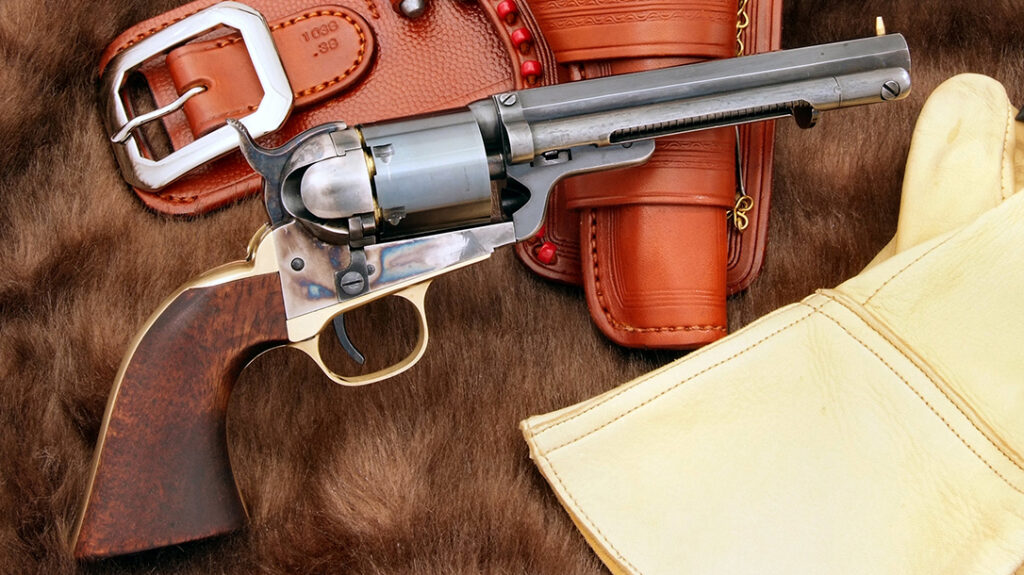
The gun and its distinctive holster and cartridge belt were auctioned off in 2009 by Greg Martin Auctions as part of the Buck Stevens Collection of Fine Colts. In the auction catalog Martin wrote: “Serial no. 87938, .38 centerfire caliber, 6-shot cylinder with naval engagement roll scene, 5-3/4 inch octagonal barrel with marking – Address Saml Colt New-York City-. Left side of frame stamped Colts/Patent. Field conversion from percussion to cartridge, with ejector rod mounted on right side of barrel, loading gate with spring, and recoil plate attached to face of recoil shield. The hammer with brazed on firing pin. Brass grip straps, one-piece walnut grips. Tooled leather holster and cartridge belt, the face of holster stamped “Geo. E. Robbins/Miles City Mont.”
More Markings
Affixed above a silver plaque, secured by copper wire, and inscribed “Buffalo Bill/Cody.” Unidentifiable decorative motif engraved at center, between the nickname and the last name. Holster embellished with hand-tooled borders, as well as fitted with brass eyelets and beadwork. Cartridge belt stamped on buckle strap 1038/.38 and on the strap engaging the buckle: “Wyeth Hdw & Mfg. Co. St. Joseph, Mo.” Buck Stevens acquired the gun and holster from the collection of Buffalo Bill’s sister, Julia Cody Goodman.
Advertisement — Continue Reading Below
The Cody gun had some unique and distinguishing characteristics that set it apart from other field conversions and distinctly apart from the Wm. Mason patent Colt 1851 Navy conversions. The ejector housing on Cody’s gun was screwed to the side barrel flat at the front and attached at the rear by a brace screwed into the first octagonal barrel flat on the right. The loading channel cut into the recoil shield was deeply recessed and the loading gate wide and long with a large hinge spring screwed into the side of the frame.
The Colt loading lever was removed, but the loading lever channel was not filled, and the barrel was shortened. It was a well done job as the muzzle was crowned after the barrel was cut back from the original 7-1/2 inch length. The cylinder was also of considerable interest as it had cutouts at the back of every chamber to expose the rim of each cartridge. The serial number dates its original manufacture by Colt’s as a percussion revolver to 1858.
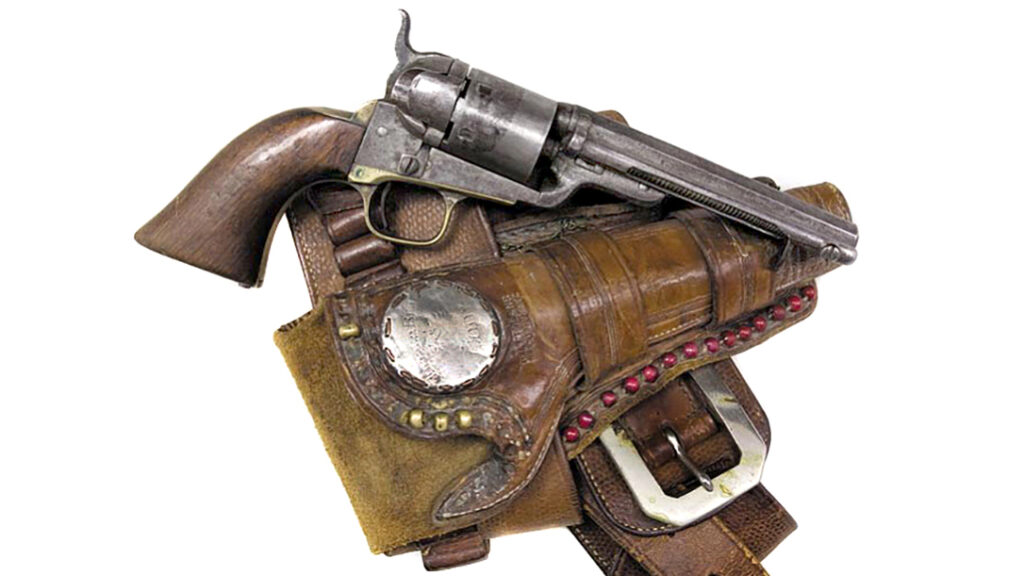
Advertisement — Continue Reading Below
Recreating Two Legendary Pieces
As has been the practice in past historic articles featuring unusual guns and holsters, the finest craftsmen are called upon to recreate these artifacts for Guns of the Old West. To duplicate the uniquely decorated holster and cartridge belt, Alan and Donna Soellner of Chisholm’s Trail Leather carefully studied pictures of the original rig and meticulously cut and hand carved the holster, fitting it with decorative brass and dark red beads like the original. The large silver concho engraved “Buffalo Bill Cody” was recreated by silversmith and engraver Roy Stokes of Coast Silver in Big Bear, California. The completed holster and cartridge belt were done to like new condition as Cody would have worn them in the 1870s.
To make the Cody field conversion 1851 Navy, most of an entire gun had to be hand fabricated, and this task was taken on by Walt Kirst of Kirst Konverter fame. He started with a brass-framed Pietta 1851 Navy, which he modified by cutting down the barrel to the same length as Cody’s gun, crowning the muzzle and mounting a tall brass bead sight set up to zero the gun in at 50 feet with the rear hammer notch. The entire ejector housing, spring and rod had to be hand fabricated along with the unique mounting system of the Cody field conversion.
More Cody Revolver Details
The .38 caliber cylinder started as a standard Kirst Konverter drop-in conversion for the Pietta 1851 Navy but then had to be custom cut to duplicate the witness slots in the Cody cylinder. The same for the Pietta’s recoil shield, which had to be specially channeled to match the Cody revolver. The drop-in breechring also required a handcrafted loading gate, spring and frame screw, making most of the conversion unique to any other Kirst conversion. The gun was given a slightly aged Colt blue finish to create an accurate copy of the Buffalo Bill Colt as it would have appeared in the early 1870s.
Advertisement — Continue Reading Below
Creating accurate reproductions of famous firearms and holsters remains a skill that few can master. Even with modern tools, it all comes down to doing things the way they were done more than 100 years ago–by hand.
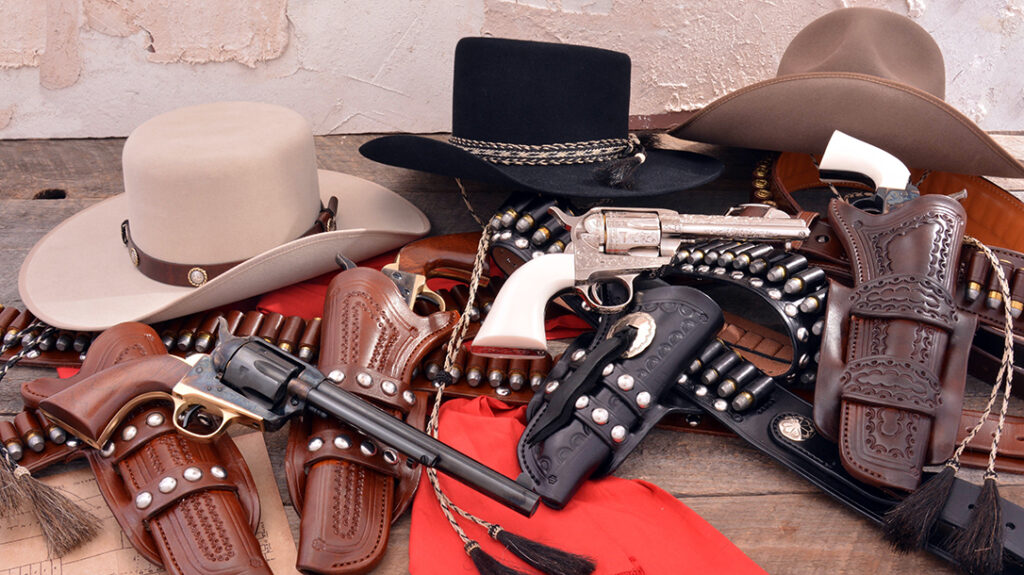
When History and Fiction Collide
Without question the most quoted western of all time is Tombstone. Based on the actual outlaws and Cowboy gangs who played out the real life drama in the unsettled Arizona territories of the 1880s, Tombstone’s villains were made larger than life, as were the heroes, Wyatt, Virgil and Morgan Earp, and their friend Doc Holliday. That is the beauty of filmmaking, turning history into entertainment, and no other western in recent time has entertained more than Tombstone.
Advertisement — Continue Reading Below
While the Earps and Doc Holliday were the heroes of the film, every hero needs a villain, and this film provided three of the most memorable ever to draw a six-shooter, Curly Bill Brocius, Ike Clanton, and Johnny Ringo. Much has been written about this classic 1993 Kevin Jarre-penned western over the last three decades, but less has been said about the bad men, without whom there would have been very little story to tell.
Dressed to Kill
The original costume designs for Tombstone by Joseph A. Porro helped establish each character’s appearance throughout the movie. Making memorable characters not only comes down to acting but costuming; developing the fine details that differentiate one man from the rest and in Tombstone with so many bad men each needed some defining feature.
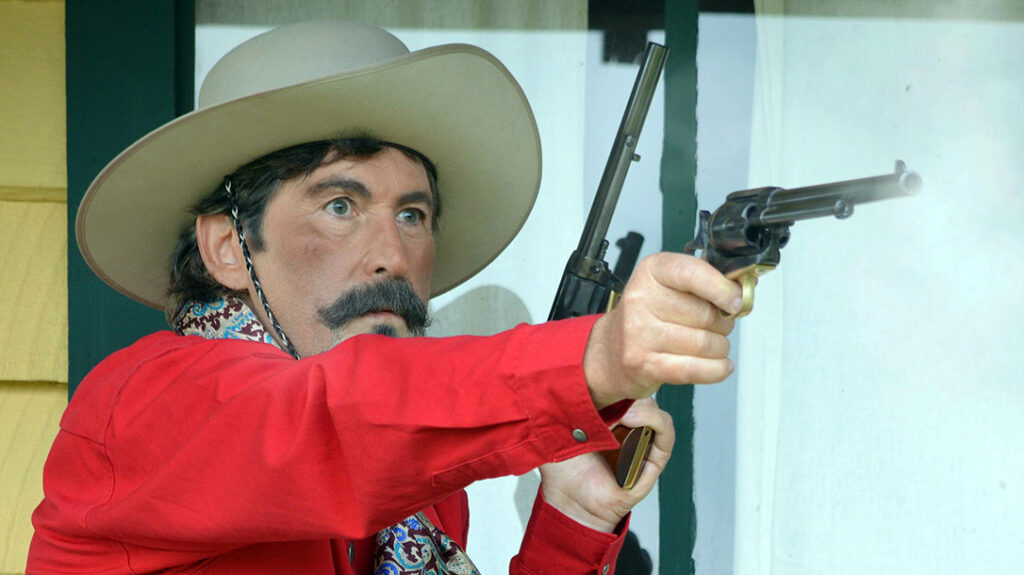
For Curly Bill it was Powers Booth’s look and delivery of lines, but it was also the distinctive red shirt, curled up hat brim, Aces boots, and that unmistakable crossed double set of gun belts and Colts. Jarre wanted everybody to look unique.
Dressing Johnny Ringo in shades of gray and black made him the personification of a classic bad man but with just enough panache to make Ringo unforgettable and guide the viewer’s focus to actor Michael Biehn’s pale blue eyes, trim mustache and goatee. His look was set off by the silver mounted holster, ivory-handled Colt and a distinctive black hat. This was even further accented by the red sash worn around the waist by each of the characters. The sash was not actually worn by the real Cowboy faction, but was something that Jarre wrote into the screenplay to imply that the Cowboys were an organized gang by wearing colors, just as do modern-day gang members. It proved very effective.
Classic Villains
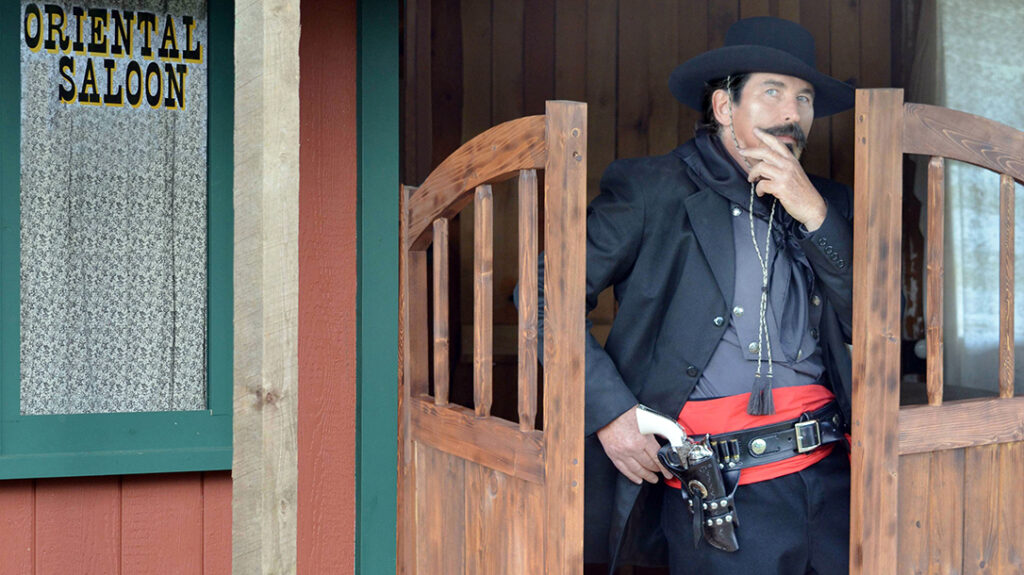
Ike Clanton wasn’t a gunfighter like Ringo or dyed-in-the wool Cowboy like Brocius. Ike was less complicated, caught between his own ineptitudes, the power of the Cowboys and his fear of facing down the Earps, because he knew Wyatt would kill him. He came off more as a hard-living cowhand, disheveled and scruffily dressed, boasting an eccentric campaign hat with turned up brim. Despite this, the one outstanding characteristic was Clanton’s handsomely hand-carved Mexican drop loop holster and ivory handled Colt, not at all what might have been expected.
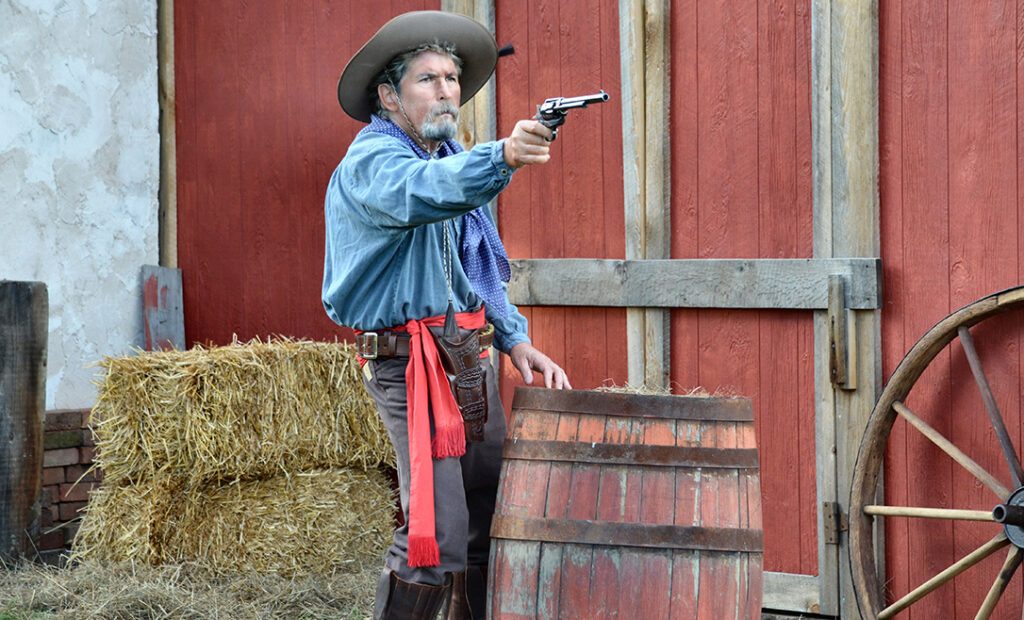
Superbly played by Stephen Lang, Ike Clanton’s character was uniquely apart from the short-fused, tortured soul of Ringo or the unbridled whit, sarcasm, and violence of Curly Bill. Each a masterfully written counterpart of the other. And their costuming further underscored each character.
The Do-Over
To recreate the look and feel of the film for Guns of the Old West’s tribute to “The Bad Men of Tombstone” required the efforts of several prominent individuals specializing in costuming, firearms and gunleather. Duplicating the clothing, hats, holsters and Colt Single Actions from the film first brought together the talents of Alan and Donna Soellner from Chisolm’s Trail Leather to craft the hand carved Curly Bill double holsters and cartridge belts, including all 40 handmade silver spots on the holsters and cartridge belts, the hand-tooled Clanton rig, and the elaborate stamped and tooled, silver stud and concho-mounted Ringo holster and cartridge belt. But much more was required.
To recreate the costuming, the author turned to Bill Knudsen of Golden Gate Western Wear. Knudsen duplicated the clothing and hats worn by the actors in the film to perfection. The Curly Bill Colts and hand-engraved Ringo 4-3/4 inch Single Action were supplied by Taylor’s & Co., the ivory-stocked 7-1/2 inch Clanton Colt by the author. The film’s exceptional costuming and attention to authentic guns and gunleather ultimately defined the good men, and the bad men of Tombstone.
